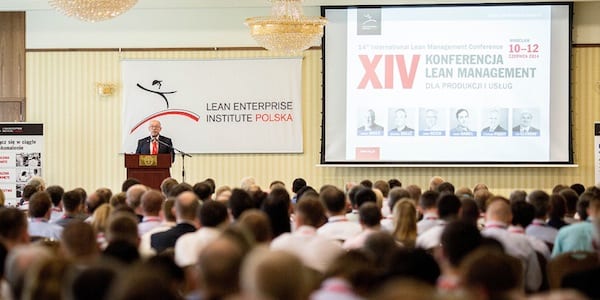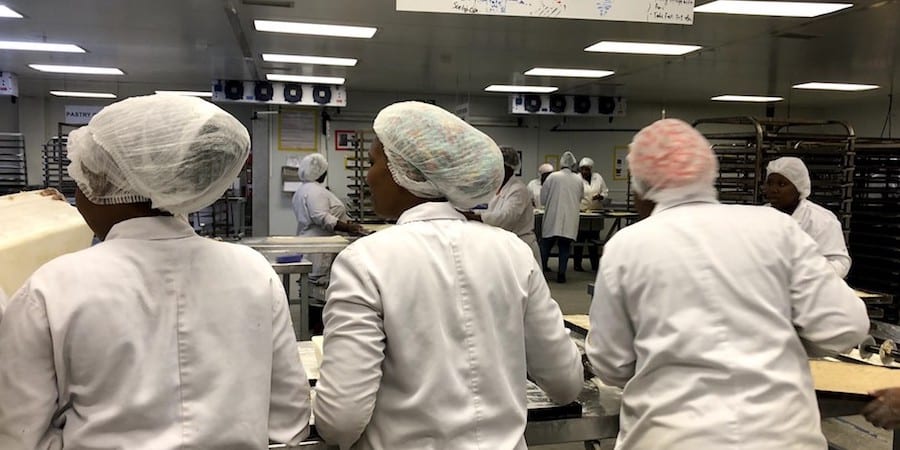
All by Yourself? Find Your Lean Trojan Horse
FEATURE ARTICLE - Sometimes, introducing lean thinking in an organization can make you feel lonely and hopeless. This article, which draws on the author's experience working with a chain of supermarkets in Siberia, offers some tips on what to do to start off a lean transformation.
Words: Rob van Gorkom, senior advisor and trainer, Lean Management Instituut
Lean can be a lonely track, at least at first. When you start off, you are often the only person who is truly convinced of the need of applying lean, and getting others on board seems almost impossible.
As someone who supports organizations in their transformation, I have experienced this many times myself. Although, I must say that the time I felt the loneliest was when I first went to Biysk, Siberia, to introduce a chain of supermarkets to the principles of lean thinking.
The cultural differences and the uniqueness of the place alone made this one of the most challenging, but ultimately rewarding experiences I have ever had. What’s very interesting to me is how resilient we can be as people: it is in those situations that you need to find ways to cope alone, and you always do. Eventually.

I have learned a few things during my 11 visits to Siberia, which I will share in this article in the form of suggestions on what to keep in mind when approaching a lean transformation on your own.
But before, I should probably introduce the company.
THE ORGANIZATION

Yuri Alexander Nikitin, who today is the CEO of Aniks, started the company 22 years ago selling chocolate bars in the streets of Biysk, a city of 220,000 located on the road between Novosibirsk and Mongolia.
Today, Aniks has 180 supermarkets across the Altay region. The company’s strategy, which management is trying to support by applying lean principles, focuses on providing fresh products, care and joy to its customers. “Creating a cozy place” is the company’s motto.
The organization wants its supermarkets to become focal points in the neighborhoods they serve, cozy places that facilitate social interaction. Management believes this is what the company is building its competitive advantage on. In an increasingly busy market (in which a lot of capital is being pumped in the form of Russian and foreign chains – Lenta and Metro respectively – that are opening their 24-hour branches all over the country), this can be a great differentiator.
THE PROBLEM AT HAND
I first visited Aniks in mid-2013 to deliver a three-day training.
Yuri Alexander wanted everyone in the company to concentrate on Aniks’ mission – Fresh, Care and Joy – and saw lean as something that could help.
“I’m interested in skills and cultural change. If Aniks wants to be successful we need to win the hearts and minds of each and every one of our employees, whom we need to turn into problem solvers,” he told me before I started my training session.
Aniks had to find a way to mobilize and engage its 5,000 employees, working in 180 shops spread over a region four times the size of Holland. “Please come over and introduce as many of us as possible to lean thinking and practice. I want us to investigate how this could help achieve our mission,” he said, aware of the crucial role people play in the improvement of daily work.
My response was something of a compromise between numbers and substance. First, I ran a training session to introduce lean thinking to 30 people, during which we discussed how lean principles could apply to Fresh, Care and Joy. Secondly, I helped them to create a strategic A3 on the issues keeping Aniks from delivering on its mission. Admittedly, I made a terrible mistake by letting so many people take part in such a complex session (strategic A3), which – sure enough – resulted in 30 very confused trainees, a very jet-lagged and frustrated consultant, and a widespread conviction among staff that many of Aniks’ problems were simply due to “Russian culture” and that there was nothing that could be done about it.
I had to cut the training short, because time was running out. My last two hours in Biysk were spent having a private conversation with Yuri Alexander. “So, is lean right for us? Can it help us?” he asked me. I reminded him of his own words – “I want my people to take responsibility for their shops” – and I explained that for that to happen it would be necessary to establish a system to unearth and solve problems every day.
I sketched the structure of a standup meeting, and went through some very basic problem solving principles before heading to the airport. Mr Alexander loved them, and asked me to come back.
Six weeks later, I was back in town to run a workshop on visual management. Together with three shop managers and their staff, we developed a standard for a standup meeting. We went through a lot in those three days (from SQDC metrics to coaching principles), and Aniks was able to successfully introduce visual management in three pilot shops. Building on this initial success, six weeks later (it was my third visit to Siberia) we were preparing managers, trainers and coaches for the roll-out of visual management and meetings to all shops over the course of 2014.
Sadly, things were actually not as good as they sounded (they never are). During my fourth visit, at the end of 2013, one of the pilot shop managers lamented that her people didn’t see the problems. “That’s a simple one,” I thought, “You guys need standards.” I therefore suggested to Yuri Alexander and Maria Sharipova, the by then appointed person responsible for the lean program at Aniks, that they create three model shops, to understand how to best manage operations.
In the following two visits, we introduced 5S (which turned out to be 3S, really) and the concept of standardized work in the pilot shops, which had proved so successful at first. We had a lot of trouble with the latter initially, with shop managers failing to see the benefits that standards could bring them and really fighting us on it.
Resistance was so strong that three hours before I boarded my flight to Siberia a few weeks later Maria told me that the managers of the model shops didn’t want to continue with the project. I thought a lot about the reasons why they were saying that, and I eventually realized that I had been encouraging them to work towards goals they didn’t feel as their own.
Unless I found a way to answer the question nagging people – “What’s in it for me?” – things would not change. If a manager’s monthly paycheck (and that of the manager’s boss, and so on) was primarily dependent on turnover but we were unable to explain what positive impact standard work could have on turnover, we simply wouldn’t get their attention. This is a very common mistake practitioners make (at least I did): for people to get on board you need to explain your objectives in terms of end-of-pipe results, in terms of practical things they can understand and influence.
So here’s my first tip…
TIP 1 - If you want to be successful in a lean transformation, you must connect the true ambitions of the group you are working with to end-of-pipe results they are able to influence.

Despite the complaints and the resistance, I still made it to Siberia for the following visit. Given the situation, I thought the best thing to do would be to focus solely on one specific problem and to forget about the rest for a moment. We picked an issue in one of Aniks’ bakeries (the chain’s shops sell freshly-baked bread, pies and sweets).
Little did I know, that’s when the situation finally started to change.
The perceived problem was one of space and capacity: Aniks bakers make products in tiny bakeries of just 8 square meters. I asked them and their shop managers what result they were after, and they said they wanted to ensure that bread is always fresh and available to customers. The ideal state would be to have as many types of bread, pies and sweets available on the shelves at all times as possible. “At least three of each, but the more the better,” they said.
That’s when we started our kaizen, by observing how many times a product was not available on the shelves.
I was told almost immediately that there was not enough capacity to have that mix of products throughout the day. “There are several processes in the bakery, and each product has a different baking time,” one of the bakers objected, “Plus, our ovens are too small.”
The analysis of the process revealed how bakeries were actually using less than 50% of their capacity, and I soon found out that management had received requests for dozens of new ovens from across the Aniks network. These machines cost between €10,000 and €12,000, and use a lot of expensive electricity. Buying a big batch of them, which the company intended to do, would be extremely costly.

We investigated the problem and noticed that batches were too big, processes really unstable, and that there was a complete lack of visual aids. I explained that reorganizing the work would allow us to have even more variety than we were hoping for. All of a sudden, I was talking about something that made all the shop managers stop and listen: standardizing the different processes and visualizing demand and the production schedule of the mixers and ovens would allow us to influence turnover. This, in turn, would boost performance on the Fresh, Care and Joy metrics.
We developed a specific sequence of actions for baking products and introduced a pull system to see what clients were purchasing off the shelves. This told us what to make next, and made replenishment possible throughout the day.
This experiment, although very simple, was extremely successful. It resulted in a 20% increase in turnover in the pilot bakeries and in the company not purchasing any new ovens.
Additionally, these great results won the hearts and minds of the bakers and of shop and senior management.
There was also another benefit to this kaizen, which leads to my second tip for you.
TIP 2 – Countermeasures don’t cost money, and should be actively and personally implemented by those taking part in the kaizen.
My next visit to Aniks saw yet another surprise.
A law in Russia prevents too many stores of the same brand from opening in the same area (but apparently not for the same company to own different brands of supermarkets in the same place), which meant that Aniks became a franchising partner to another chain and opened the first SPAR-branded shop in the region.
Compared to Aniks, SPAR stores also sell hot meals and fresh salads. Or at least they are supposed to. When I visited, Aniks’ SPAR store had tremendous amounts of waste and was producing food of very low quality. People were working hard, but the results were simply not there.
In four days (the duration of my visit) we quantified waste in the shop, which was a shocking 80% of the supply of fresh food. A spaghetti chart, which we did at 6am in the shop’s kitchen, revealed that nobody really knew what was going on and that people were working really hard but had no idea of what their actual role was.
We made an A3 and in just four days we managed to reduce the lead-times to make the salads in the morning from four hours (with three cooks) to one hour and twenty minutes (with one cook).
However, the real lesson the visit taught me had nothing to do with a successful kaizen. Besides all the efforts we had made in the bakeries and elsewhere at Aniks, Maria and I had also worked hard to build and train a team of internal lean practitioners, in order to create a base of knowledge and experience the company could rely upon. At the end of the event, one of the trainees, Olesya, who co-ran the kaizen event at the SPAR shop, told me: “Thank you, Rob, now I finally understand what you mean by PDCA.” After all the “classroom” training on the philosophy, principles, and tools (A3 thinking in particular), it was actually the practical, on-the-job experimentation that did the trick. So here’s my next tip:
TIP 3 – When developing people, focus on taking them with you on the gemba and encourage them to try PDCA for themselves, and to run experiments.

To finish the story, we must go back to the bakeries. Besides improving the process, the kaizen made the bakery easier to manage by introducing two visual aids. The first is a very simple A4 diagram displaying all the products that should be on the shelves at each time of the day. By checking every hour whether the products are actually available or not, bakers and shop managers can notice problems at an early stage. The second aid is a visualized sequence of the production schedule, time and activities (both for men and machines) for each baking cycle of the day, which immediately shows whether the bakery is on schedule or not.
Together, these visual tools proved especially valuable for shop managers who, prior to the kaizen, didn’t have a clue of what was actually happening (let alone what should be happening) in the bakeries. In the end, one of the bakeries was doing extremely well, while the other was making no actual progress. There is no doubt that the success of the first one came down to the manager getting involved and talking to her bakers every day, solving problems with them, and constantly monitoring whether fresh products were on the shelves or not. So my fourth and last tip:
TIP 4 – Always visualize the earliest point of deviation to enable management to embrace their role as lean leaders.
In the spring of 2014 Maria, my interpreter Olesya and I invited senior shop management Larissa and Elena (each of them responsible for 80-90 shops) to one of the pilot bakeries at 10pm. Natalya, the shop manager, was also present, as she wasn’t comfortable having Elena and Larissa over without her being there. Once we were inside (the shop was closed) Natalya started to tell about the changes the shop had implemented. There was such enthusiasm in her voice and she seemed so engaged that Olesya leaned forward and whispered to me: “I think your job is done, Rob.” That was the first time, after months of doubts and questions about the “ROI of lean,” that we had full management commitment: for the results but most of all for the way those results were achieved. In the end, in the bakeries we succeeded in connecting end-of-pipe results to turnover and in doing so we got people and management interested in concepts like standardized work, 5S and visual management. In a way the bakery kaizen became our “Trojan Horse” to introduce lean at Aniks.
So what happened next? During my last visits of 2014 we developed and tested a program for bakers and shop managers to improve the freshness and availability of bread, pies and sweets on the shelves. To read about the results, but also about Maria’s experience introducing lean at Aniks, please read her note below.

“Rob’s article made me excited as it allowed me to reminisce about our achievements and the difficulties we faced while working together and the ways we overcame them. The feeling of loneliness he talks about at the beginning of the article reminded me of my own and made me think of how much Rob helped me to cope with it. So, my advice to people who are only at the first step of their journey is to have a lot of patience as not everyone – at least at first – will be sharing your values and think in the same way you do. Don't give up or feel disappointed, though. Believe in what you are doing, achieve some initial results and you will be heard eventually.
I also fully agree with Rob when he talks about the necessity to show people their real goals in connection with the end-of-pipeline result.
Even today, after successfully introducing lean in more than 100 bakeries (where we achieved great results in terms of quantity and quality of products and an increase in turnover), I constantly remind people of what sets lean apart from other approaches and the essence of these principles.
Working with Rob was an invaluable experience for me and my team, and I would like to thank him for all that he has done for Aniks.”
Maria Sharipova, lean program manager, Aniks
THE AUTHOR

Read more


FEATURE – In part 2 of his article, the author unveils an improved process that allows this Hungarian company to replace machine parts with minimal production downtime.


REVIEW - Roberto Priolo reviews the 14th Lean Management Conference, held earlier this month in Poland. With great presentations and speakers, the event left him with a lot to reflect on.


FEATURE – How reading lean books empowered people and transformed the managerial culture at an industrial bakery in the Western Cape Winelands in South Africa.


INTERVIEW – We have come to dread having to interact with customer support representatives, and quite rightly so. Basecamp has made it a mission to bring humanity back to this interaction.

